A collection of pictures of soldiers with their armour/equipment (recreated from historical accounts).
Hoplite (5th century BC)
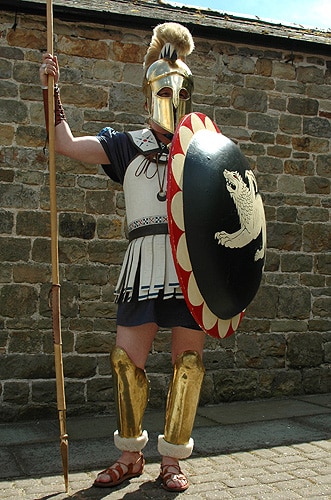
A hoplite of the Greek style.
In earliest Roman history soldiers fought in much the same equipment Greek warriors used.
Of the five classes defined the in the census, the first class was made up of those wealthy citizens who possessed the best armament.
This excellently equipped hoplite would therefore no doubt be of the first class.
Veles, plural: velites (3rd/2nd century BC)
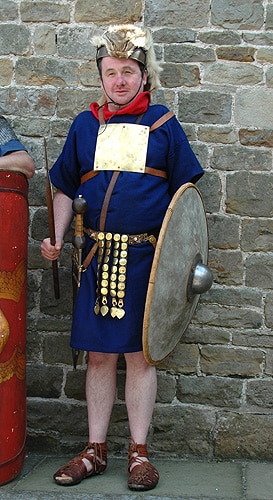
The velites were lightly armed skirmishers who operated in front of the army in loose formation.
Their role was hence to harass the enemy, to provoke particular units into battle or to simply distract from the manoeuvres of the main body behind them.
Note: Against Hannibal, the velites proved an excellent foil for the elephants, drawing them through and away from the Roman battle lines.
Given his role, a veles needed to be young, fast and agile.
Here he carries a short javelin. It is likely that a veles may in fact have taken a collection of javelins into the field, as they very probably will have been his main weaponry. It is possible that they operated in teams of two, one bearing the weapons and operating as a shield man, the other engaging the foe with javelins.
Hastatus (3rd/2nd Century BC)
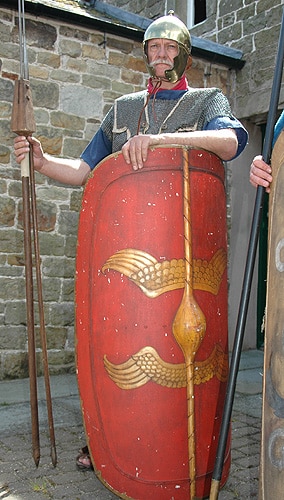
This may in fact be a hastatus or a principis. The distinction of the two forms is not quite clear.
The hastati formed the first battle line, ahead of the principes. The final, third line was held by the triarii with their long spears.
Both the hastati and the principes were similarly armed, hence they are hard to keep apart.
A large curved shield, larger and heavier than that of the later legionaries, a simple bronze vaulted helmet with two side panels, chain mail body armour, a sword and a complement of pila (throwing spears).
Triarius (3rd/2nd Century BC)
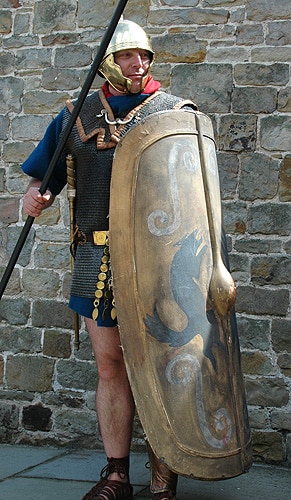
The triarii formed the heavy backbone of the early republican legion. It is behind them the lesser armed velites, hastati and principes could retire if the worst came to bear. ‘It has come to the triarii.’ was a traditional Roman saying describing a crisis.
The triarii bore some similarity to the Greek hoplites because in essence they will have operated in the same way, forming a wall of shields, bristling with lances.
Here our triarius is equipped with a large curved shield, larger and heavier than that of the later legionaries, a simple bronze vaulted helmet with two side panels, chain mail body armour, a sword and a long spear with which to keep the foe at a distance.
Look closely and you see that his left leg only is armed with a bronze greave (shin guard). The left leg would be the forward leg, closest to the enemy.
Auxiliary Infantryman

An auxiliary infantryman of the first century AD. His armour and equipment are decidedly inferior to that of the legionary. He wears a light mail shirt and a Gallic helmet. Instead of the sophisticated pilum, the throwing spear of the legionary, he carries the hasta, a more basic stabbing spear.
His light shield is flat and oval, offering no corners to snag. It hence is a shield better suited to for fighting invidually, in loose formation or in difficult terrain.
This is equipment suited to a light mobile fighter, rather than to the disciplined heavy infantry on the battle field.
Syrian Auxiliary Archer
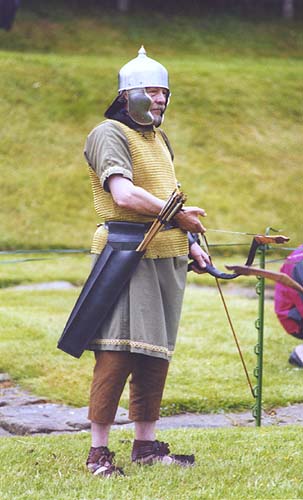
The eastern provinces were particularly known for their archers, using powerful composite bows.
Syrian archers should serve across the empire as auxiliary forces.
Vexillarius (1st century AD)
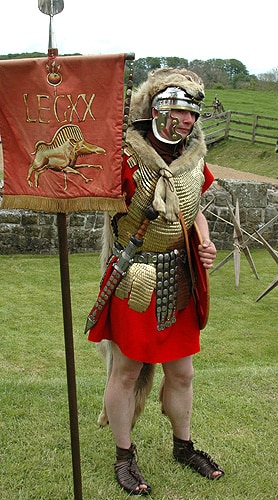
A first century vexillarius. His armour and helmet are covered in a wolf skin and he would usually also carry a small circular shield.
The vexillarius takes his name from the type of standard he carries, the vexillum. The vexillum was used as the typical standard for cavalry or, as in this case, in the infantry for detachments of varying sizes. Such a detachment could be of any number of men and is known as a ‘vexillation’.
Their standard would signify which larger unit they would belong to, in this case the 20th legion.
Signifer (1st Century AD)
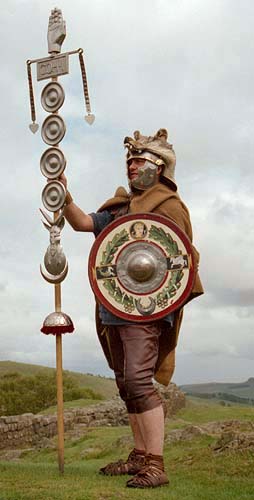
A first century signifer. His armour and helmet are covered in a wolf skin and he also carries a small circular shield.
The signifer takes his name from the type of standard he carries, the signum. The signum was used as the standard for each maniple in the legion (a maniple consisted of two centuries).
Aquilifer (1st century AD)
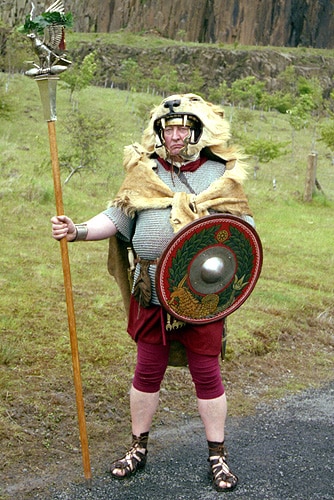
A first century aqulifer. His armour and helmet are covered in a lion skin and he also carries a small circular shield.
The aquilifer takes his name from the type of standard he carries, the aquila (the ‘eagle’). The aquila was the standard of the legion. It was the item which had to be defended at all cost, as it represented the legion’s honour.
Bearing the legion’s most prized possession the aquilifer’s position was of high standing. In fact, one of the aquilifer’s duties was to be in charge of the legion’s pay chest. He would therefore also be the man to whom the legionaries and officers would entrust their savings.
Cornicen (1st Century AD)
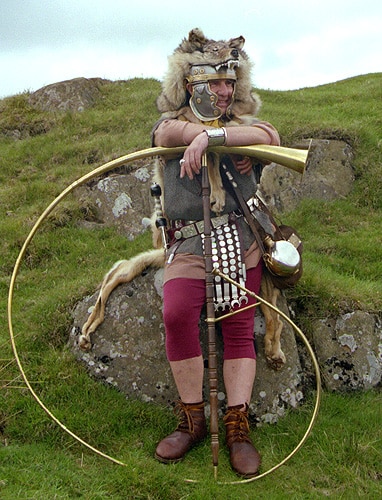
A first century cornicen. His armour and helmet are covered in a wolf skin. He would usually also carry a small circular shield.
The cornicen is one of the trumpeters of the legion. In battle he would use his horn, called the cornu, to draw the attention of the soldiers to any new order being signalled.
Imperial Legionary (1st century AD) – in lorica segmentata
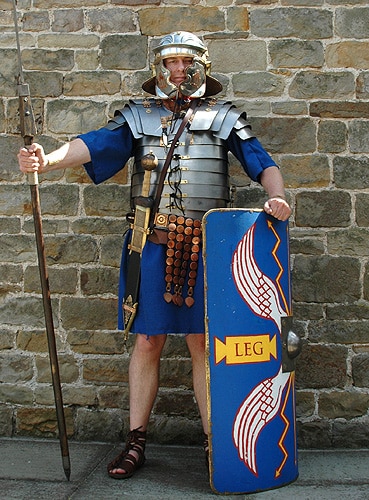
A legionary wearing the famous banded armour, the lorica segmentata, and the typical imperial ‘Gallic’ helmet.
Also he has with him the famous curved, square shield, the gladius (sword) and a throwing spear (pilum).
Notice that by this time the helmet was a sophisticated device, featuring deflection areas and rims designed to crimple on impact and so absorb blows.
The rear neckguard is clearly visible, protecting from blows from behind. The cheek guards feature deflection panels to direct blows away from the neck.
The rim on the forehead would not merely prevent rainwater from running into the soldier’s face, but would also absorb a downward slash of a sword. Even the ear openings are furnished with such rims.
Imperial Legionary (1st century AD) – in lorica hamata (chain mail)
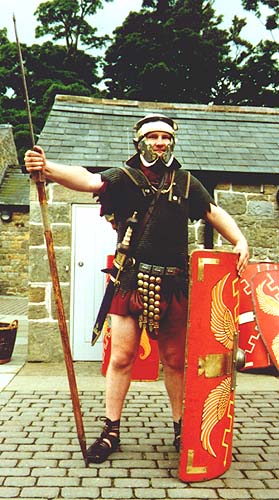
A first century legionary wearing chain mail armour, the lorica hamata, and the typical imperial ‘Gallic’ helmet. Also he has with him the famous large square shield.
Decanus (1st Century AD)
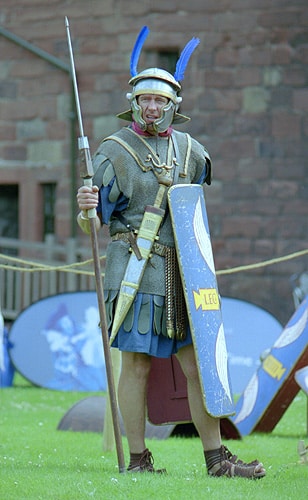
The decanus was the first man of an eight man contubernium unit. A normal soldier without formal command he was most likely in charge of various tent or barracks duties.
In everyday army life his was most likely a post of no immediate importance, but when the army was on the march and a marching camp needed erecting, the decani would more than likely be a great importance as team leaders in getting the tents unloaded and erected.
This insignia of the decanus were the two feathers on his helmet.
Optio (1st Century AD)
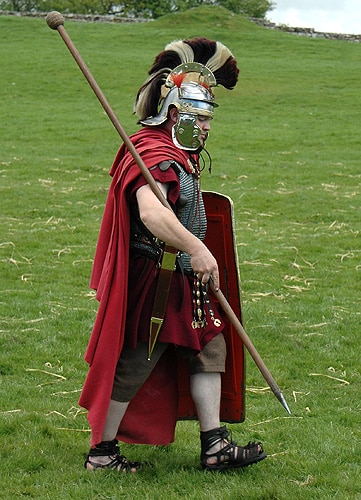
The optio was the second in command of a century.
Unlike the centurion’s, the optio’s equipment and armour differed little from that of the ordinary soldier.
The main indicator of his rank, was the optio’s staff. It’s generally believed that the main use of this staff was to help in arraying men in ranks and columns.
The reach the pommelled staff granted him, would also allow the optio to get the attention of individual men in the ranks during battle.
Further to this, the optio is said to have worn a special ring, denoting his rank.
This fine example of an optio wears a crest which would only have been used on special parades. He wears a red cape, usually the denotation of a centurion. But given the optio’s position as second-in-command, this may indeed have been possible.
Centurion
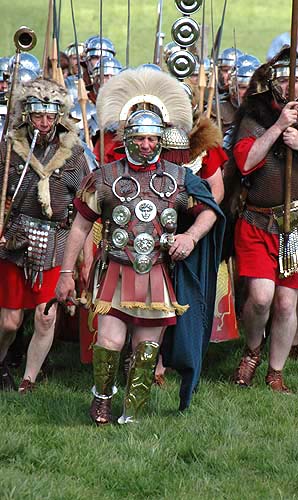
The centurion’s armour varied widely, perhaps it was even a matter of individual choice. The centurion depicted wears leather. The rings (torques) and circular plaques (phalerae) on his torso are awards he has won in battle, comparable to medals in modern day armies.
The horsehair crest across his helmet made him easily recognizable by everyone, even in the chaos of batte, as a officer of considerable rank.
The greaves he wears to protect his shins are also a sign of his being a centurion. A cape was usually also seen as a mark of a centurion. Although, given that their style of dress may well have been down to their own choice, this centurion may not be at all out of place without such a cape.
Note also the vine rod he holds in his hand. A further insignia of his rank and one he would happily use to beat unruly soldiers with to enforce discipline.
Legatus (1st Century AD)
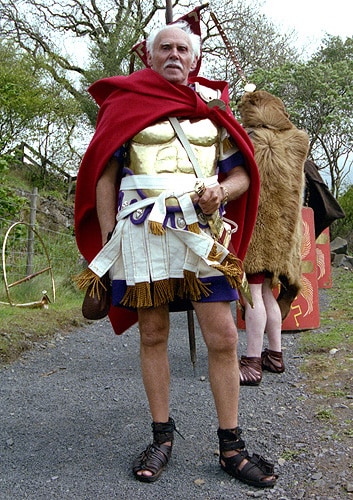
The legatus was the commander of a legion. He would be of senatorial rank.
Here he wears a bronze chest plate. The purple on his tunic points to his being of the senatorial order.
Imperator (2nd Century AD)
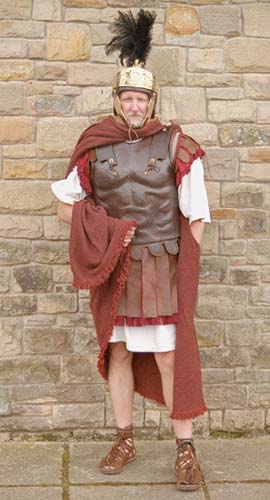
The term imperator strictly speaking only befitted a victorious Roman commander. Republican commanders such as Julius Caesar were hailed imperator by their troops after victories. However, it was a title which the emperors chose for themselves as commander in chief of the Roman imperial army.
In this case, you see a suggested recreation of emperor Hadrian’s appearance.
Imperial Legionary (2nd Century AD)
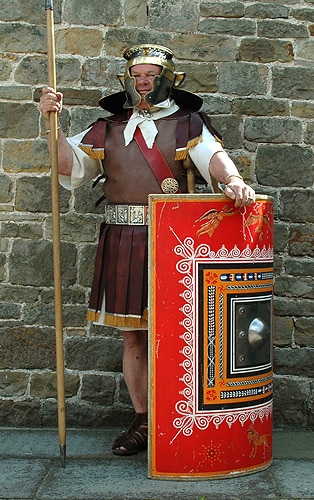
Notice the development of the helmet seen in the 1st century AD has now been taken yet further. The neckguard by now is massive. So too are the impact rims on the forehead and at the ear holes.
This here may well be a more ceremonial outfit, as it seems to offer little serious protection. The second century legionary didn’t differ very substantially from his better known predecessor from the first century.
Legionary (3rd Century AD)

The legionary of the later Roman empire generally carried a large oval shield, a large helmet much like that of the later medieval knight, and a suit of chain mail or (as in this case) scale mail. The famous pilum spear was largely abandoned for several martiobarbuli (light, short throwing spears as shown on this picture) as well as a long lance with which to hold off cavalry.
Late Legionary (3rd/4th Century AD)
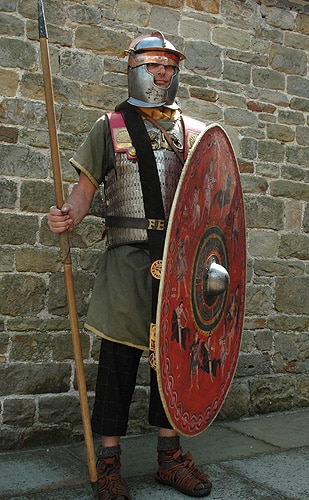
By the late third century the barbarian influence upon the army began to be ever more noticeable. Slowly the army begins to move toward the appearance of their Germanic enemies, from whence many of her recruits are coming.
The very large, almost round shield clears bears little resemblance to anything the prior generations of Roman soldiers used.
If there was still any doubts regarding this soldier’s heritage, one need only look at the trousers on his legs.
The helmet worn here is the subject of some discussion as it isn’t really clear if it was a cavalry helmet or an infantry helmet of the age. Either way it seemed to have severely restricted movement of the head.
The lamellar armour (a type of lorica squamata) borne by this soldier is fairly typical of the age and shows that , prior to the demise of body armour among the ever more mobile soldiery, the legions of the 3rd and fourth century were still largely heavily armoured.
Late Legionary (5th Century AD)
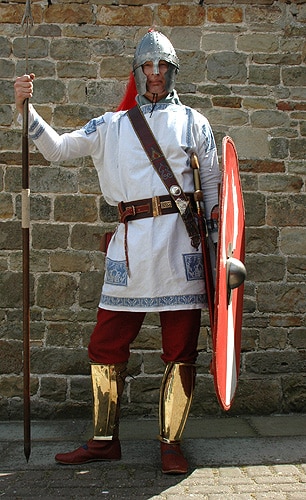
By the fifth century the barbarian nature of the army was barely disguised. Germanic warriors dominated the ranks and looked the part.
Armour has been given up for greater speed and mobility, as the mobile field army needed to move fast to head off any invaders.
Gone are any curved, square shields. Gone is the sophisticated design of the helmet. Gone is the short stabbing sword. Instead the soldiers is armed with a heavy Germanic spatha.
Centurion (3rd Century AD)
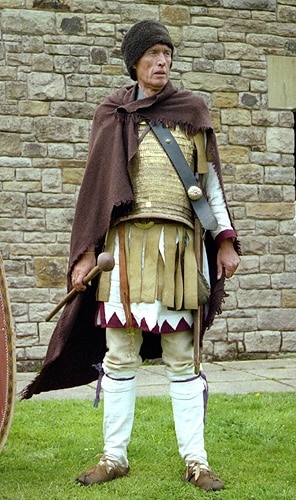
When compared to the centurion of earlier age, the centurion of the third century remains virtually unchanged. He even still carries a stick with which to keep his legionaries in line with. Just like his predecessor his helmet and shield would look much like that of the contemporary legionary. And like the soldiers, his sword, too, has now changed from the short gladius to the longer spatha.
Cavalryman (1st Century AD)

A horseman of the ala of the 1st century AD.
For protection wears chainmail, a ‘gallic’ helmet and carries a large, oblong shield.
His weapons consist of a long hasta (spear) and a long sword (spatha).
For practical purposes the cavalry did wear short trousers of sorts.
Italian cavalry never did too well on the battle field. Spanish, Gallic and Numidian cavalry proved much superior. So by the first century AD Roman cavalry consisted almost entirely of horsemen raised from the various provinces of the empire.
Note that the Roman cavalry rode without stirrups.
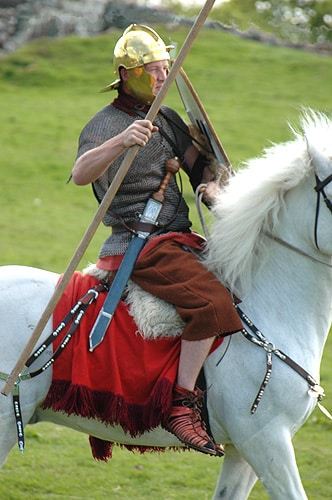
Late Cavalryman
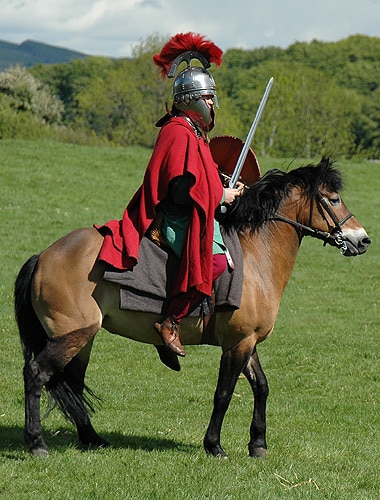
An example of a late Roman cavalryman, perhaps 5th century AD. His helmet and chainmail already look very much like the armour of later medieval knights. He bears a light, round shield and a lance for stabbing. The sword of the Roman cavalryman was the spatha, a long-bladed weapon, granting the rider a much greater reach than the legionary’s short gladius.
Much of the precise armoury and weaponry of late Roman cavalry is guesswork. In this case, spot the quiver carried behind the saddle, holding arrows for use with the bow.
The prefered mode of battle for the Roman cavalry (ala) was fall into the rear or the flanks of an enemy already deployed against Roman infantry. It proved at its most devastating when it rode down fleeing troops, lancing the fleeing soldiers in their backs. In fact most of the slaughter in ancient battles is thought to have occured, when the opposing army broke and fell into disorder and the cavalry fell upon the panicked and fleeing enemy.
Note that the Roman cavalry rode without stirrups.

Legionary at Practice

The soldiers of the Roman army would daily practice their combat skills. For this they would use shields made from wickerwork and wooden swords in order not to injure each other.
‘Marius’ Mules’
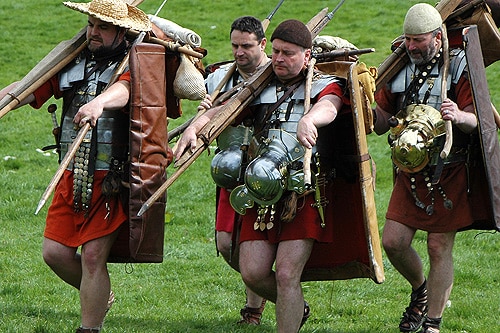
The soldiers of the Roman army would carry with them a considerable abmount of kit. When on the march they carried over their shoulder a contraption (sometimes described as a forked stick) which would help them to carry some of their equipment. Here is an of an legionary bearing this item over his shoulder together with his pilum.
So weighed down were the soldiers by all their stuff, that they were nicknamed ‘Marius’ mules’ (after the famous Roman general to whom the invention of the very forked stick is ascribed).

Historian Franco Cavazzi dedicated hundreds of hours of his life to creating this website, roman-empire.net as a trove of educational material on this fascinating period of history. His work has been cited in a number of textbooks on the Roman Empire and mentioned on numerous publications such as the New York Times, PBS, The Guardian, and many more.
